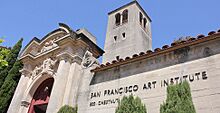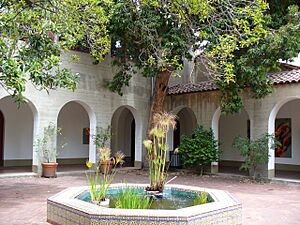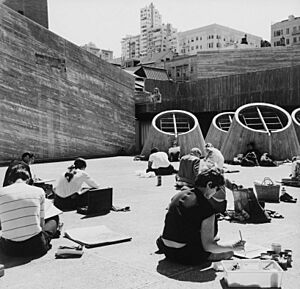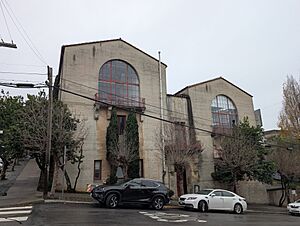San Francisco Art Institute facts for kids
 |
|
|
Former name
|
California School of Design, Mark Hopkins Institute of Art, California School of Fine Arts |
|---|---|
| Type | Private art school |
| Active | 1871–2022 |
| Chairman | Lonnie Graham |
| Interim Chief Operating Officer | Mark Kushner |
| Students | 332 |
| Location |
,
,
United States
37°48′12″N 122°25′02″W / 37.803456°N 122.417144°W |
| Campus | Urban 4 acres (1.6 ha) |
| Colors | Gray and clear |
| Mascot | Fog |
| Designated: | 1977 |
| Reference #: | 85 |
The San Francisco Art Institute (SFAI) was a private art college in San Francisco, California. It focused on contemporary art. Founded in 1871, SFAI was one of the oldest art schools in the United States. It was the oldest art school west of the Mississippi River. In 2021, about 332 students were studying there. The school officially closed its doors in July 2022.
Contents
History of SFAI
How SFAI Started (1800s)
The San Francisco Art Institute began in 1871. It started with a group called the San Francisco Art Association. This group included artists, writers, and community leaders. They wanted to support local art and artists. They also aimed to create a school and a museum. Their goal was to protect the unique art style that grew in the Western United States.
By 1874, the Art Association had many members. They raised enough money to open an art school. They named it the California School of Design (CSD). Virgil Macey Williams became the school's first director. He was a painter who had studied in Italy. Under his leadership, the CSD became well-known. It also collected many early California art pieces for a future museum.
In 1893, Edward Francis Searles gave the Hopkins Mansion to the University of California. This beautiful mansion was for the Art Association to use. It was named the Mark Hopkins Institute of Art. Both the CSD campus and the Art Association's collection were housed there. University of California students could also take classes at the CSD.
Changes in the 1900s
In 1906, a huge fire followed the 1906 San Francisco earthquake. The fire destroyed the Mark Hopkins Institute of Art. The CSD's buildings, records, and art collection were all lost. Rebuilding was difficult because they received little money from insurance. However, within a year, the Art Association built a new, smaller campus. It was in the same spot and was called the San Francisco Institute of Art.
In 1916, the Art Association joined with another group. The school was renamed the California School of Fine Arts (CSFA). This name showed its goal to support regional art. In 1926, the school moved to 800 Chestnut Street. This became its main campus. In 1930, the famous Mexican artist Diego Rivera painted a mural there. It is called The Making of a Fresco Showing the Building of a City.
Many important artists were connected to the school in its early years. These included Eadweard Muybridge, a photography pioneer. Maynard Dixon painted the American West. Henry Kiyama created one of the first graphic novels in the U.S. Sargent Claude Johnson was a well-known African-American artist. Gutzon Borglum created the famous Mount Rushmore sculpture.
After World War II ended in 1945, the school became a center for Abstract Expressionism. Famous artists like Mark Rothko taught there. In 1946, Ansel Adams started the first fine-art photography department. Other great photographers like Dorothea Lange taught with him. In 1947, Sidney Peterson began the first film courses.
By the 1950s, the school was part of the Beat Movement in San Francisco. Artists like Jess Collins studied there. A new style of art emerged, mixing abstract art, figures, and jazz. Artists like David Park led the Bay Area Figurative Movement. Students explored new ideas and materials. Many became part of the Funk art movement.
In 1961, the school was renamed the San Francisco Art Institute. SFAI believed that all art forms were important. It was a leader in new art styles. These included performance, conceptual art, and new media. In 1969, a new part was added to the building. It created more studio space, a theater, and galleries.
In the 1970s and 1980s, art often involved video, music, and social action. Teachers included Angela Davis and Robert Colescott. Students included Karen Finley, a performance artist. The school also became a hub for Punk music. Bands like the Mutants and the Avengers started with SFAI students. Technology also became part of art.
Since the 1990s, art at SFAI connected more with the world. Students created public art and community projects. Artists like Barry McGee were part of the Mission School movement. They brought their art to the streets. The school's history was recognized in 2016. Its campus was listed on the National Register of Historic Places.
Why SFAI Closed
The school faced many money problems. It had fewer students and high building costs. The COVID-19 pandemic also affected its income. On March 23, 2020, SFAI announced it would stop accepting new students. The school tried to merge with the University of San Francisco in 2022, but the deal did not happen.
On July 16, 2022, the San Francisco Art Institute closed permanently. It stopped offering degrees. However, it planned to remain a nonprofit group. This group would protect its name, records, and history.
In April 2023, SFAI filed for bankruptcy. The campus was put up for sale. This included Diego Rivera's famous mural, The Making of a Fresco, Showing the Building of a City.
In February 2024, a nonprofit group bought the campus. This group was supported by Laurene Powell Jobs. They plan to continue using the building for art. It will house the California Academy of Studio Arts. This new academy will offer free study programs to young artists.
What SFAI Taught
SFAI offered different types of art degrees. These included Bachelor of Arts (BA) and Bachelor of Fine Arts (BFA). They also offered Master of Arts (MA) and Master of Fine Arts (MFA) degrees.
Photography Programs
Ansel Adams started the Photography Department in 1945. It was the first program of its kind. It focused on photography as a fine art. Adams designed the school's darkrooms. He also brought in famous photographers to teach. These included Dorothea Lange and Imogen Cunningham.
Painting Programs
The Painting Department at SFAI was home to many famous artists. These included Clyfford Still and Mark Rothko. It was central to important art movements. These included Abstract Expressionism and Bay Area Figuration.
New Art Forms
Howard Fried started the performance and video department. This later became the New Genres department. In the late 1970s, old photographs by Eadweard Muybridge were found. Selling these helped fund the new department. Muybridge had shown the first moving pictures on campus over a century before.
Music and Art
Many artists who studied at SFAI were also musicians. These included Jerry Garcia from Grateful Dead. Dave Getz played drums for Big Brother and the Holding Company. Prairie Prince was from The Tubes. Debora Iyall was from Romeo Void. Courtney Love also studied there.
Student Housing
In 2010, SFAI moved its student housing to two locations in Nob Hill. These were Sutter Hall and Abby Hall. In spring 2020, the housing program ended due to money problems.
Art Shows and Public Events
Students at SFAI could see many art shows and lectures. These events connected students with other artists and new ideas. The Walter and McBean Galleries on campus showed art by international artists. Students could also display their own work. They could show it in places like the Diego Rivera Gallery.
Adaline Kent Award
The Adaline Kent Award was given each year to a promising California artist. Adaline Kent was a sculptor and a former student. She left money to start this award after she passed away in 1957.
Famous People from SFAI
See also
- Index of San Francisco Art Institute Alumni
- Diego Rivera Gallery
- List of San Francisco Designated Landmarks
- University of the Arts





